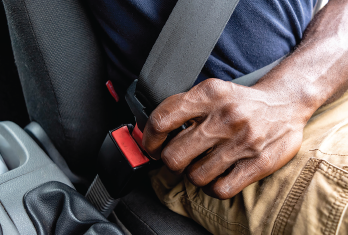
photo credit: Red Confidential/shutterstock.com
Some were furious.
State by state, laws were enacted to ensure compliance. In most states, the laws were accompanied by a modest fine, as an added incentive. By the time the laws were written, most understood they were based on good science and common sense. The potential to save lives and prevent tragedy was finally seen as a prerogative of the state.
Predictably, most went along with the new inconvenience. Equally predictably, others were incensed. Newspapers carried stories of protesters loudly proclaiming their right to self-determination and lamenting the rise of the nanny state. The data clearly demonstrated that lives could be saved. Nevertheless, a vocal minority asserted their natural right to decide what to do with their own bodies.
We are talking, of course, about seat belt laws.
Seat Belts 101
The seat belt is an ancient invention. The first iteration was created by George Cayley, an English engineer who wanted a device to keep him from falling out of his glider. On Feb. 10, 1885, Edward J. Claghorn was awarded the first patent for a seat belt. Today, we would be more likely to call his invention a safety harness. It was designed primarily to affix the user to a larger object, such as a ladder or a tree, while leaving the arms and legs free.1
In 1959, Nils Bohlin, an engineer at Volvo, created the familiar three-point seat belt that now greets you when you open your car door. Volvo gave the invention to its rivals, gratis, to encourage other manufacturers to install seat belts in their own cars. The company’s reasoning: The lives saved were worth much more than any amount it could have earned by selling the design.2
In fact, we have known since the 1950s that seat belts save lives. Volvo was able to demonstrate this early on with its crash test dummies. The company’s engineers subsequently demonstrated that using a seat belt reduced car crash mortality by 50%.3 Multiple studies later, that one statistic holds true.
Our experience with seat belt legislation demonstrates that when it comes to public health initiatives, education is not enough.
Seat Belt Legislation
Seat belts are such an intuitive invention, you would have thought that they would sell themselves, like air conditioning in Houston or sunglasses in Los Angeles.
You would have been wrong.
In fact, so much opposition was raised to this intervention that a century would pass from their invention to the time seat belts were required by law.
On July 22, 2021, former Sen. Claire McCaskill (D-Mo.) tweeted, “Serious question. Could the U.S. pass a mandate for seat belts in today’s political climate?”4 I’m not sure Sen. McCaskill realized the U.S. has never passed a mandate for seat belts, at least not in the way you may think.
The first seat belt law passed in the U.S. was, indeed, a federal law. Title 49 of the U.S. Federal Code, Chapter 301, Motor and Safety Standard, was passed on Jan. 1, 1968. The federal code, however, merely requires manufacturers install seat belts in cars. Whether drivers would be required to use them was left to individual states to decide.
Thus, we are left with a hodgepodge of laws governing the use of seat belts. In 18 states, seat belt laws are subject to secondary enforcement, meaning a driver can be cited only if they are stopped for some other infraction. In one state—New Hampshire—there is no requirement to use a seat belt, and adult drivers are free to do what they please.5
All of this leads us to the question: How did seat belts become standard in the U.S., and more importantly, why were they so controversial?
Seat Belt Naysayers
Saying that seat belts were unpopular when they first came around is an understatement. In 1949, Wisconsin-based Nash Motors became the first car company to offer them as an additional feature. Almost no one asked for them. In 1968, when seat belts became standard equipment, some drivers responded by cutting them out of their vehicles. In 1982, when Michigan State Rep. David Hollister introduced a state seat belt law, he received hate mail comparing him to Hitler.6 The reception to such laws in other states was similarly cool. In the 1980s, only 14% of all Americans used seat belts.7
Seat belt deniers largely cited three arguments:8
- Personal freedoms: Seat belts are a choice. Everyone should have the right to decide, for themselves, whether to use one;
- Personal choice: Seat belts are uncomfortable or cumbersome; and
- Fear of the technology: Seat belts would make it difficult to escape a damaged car. In a car crash, it would be safer to be thrown free of the wreckage, beltless.
Car companies were no more enthusiastic about pushing seat belts on customers. After all, they were bad advertising: If the seat belt is such an important feature, is the car really safe to drive? An emphasis on safety innovations, such as seat belts and car seats, left the impression that something was wrong with the car.9
Resistance to seat belts essentially vanished over a few decades. By 2010, 85% of drivers reported they routinely used a seat belt; by 2019, usage increased to 91%.10 For most of us, it’s hard to imagine driving any distance without first buckling up. What caused the change?
Most credit nationwide public education campaigns. Police began to report seat belt use along with car crash fatalities. Photographs of beltless car crash victims made their way into local news broadcasts. Studies demonstrating the mortality benefits associated with the use of seat belts were touted. Signs reminding drivers to use their seat belts became commonplace. Celebrities appeared in public service announcements, asserting that using a seat belt was the right thing to do. Widespread informational campaigns directed toward specific populations played an important role in normalizing the use of the seat belt nationwide.
That last statement is absolutely true. Sort of.
Public education leading to improvements in public health is a nice story. In truth, the story may be an example of revisionist history. Public education clearly played a role in the adoption of seat belts in the U.S. But the complete story is not quite that straightforward. Public education campaigns promoting the use of seat belts started in the 1970s and largely failed to change public behavior. Seat belts remained an unpopular intervention until 1985, when states began to enact laws enforcing their use.
So what happened?
Unsurprisingly, the full answer involves lawyers. And money. Lots of money.
Money, Lobbyists & Other Complications
In 1966, Congress passed the National Traffic and Motor Vehicle Safety Act. This act empowered the Secretary of Transportation to issue standards to promote motor vehicle safety. In 1967, the Department of Transportation issued Standard 208, which required that all automobiles have seat belts. In 1975, the standard was revised to require passive restraints, such as air bags, which would automatically protect the driver, whether or not they chose to use them.
This is where things get complicated.
In 1976, Secretary of Transportation William Coleman suspended the requirement for passive restraints. The requirement was reinstated by the next Secretary of Transportation, Brock Adams, and then again rescinded under Secretary of Transportation Andrew Lewis’ watch.
This is where the money comes in.
Insurance companies stood to lose significant amounts of cash if safety standards were reduced, so they did what Americans do: they sued. In 1983, State Farm Mutual Automobile Insurance Company and the National Association of Independent Insurers took the government to court.
In a unanimous opinion, the Supreme Court of the United States said the government didn’t have the right to keep changing its mind. To rescind a rule, the government needed to have a good reason. To rescind a law just because a new person was Secretary of Transportation was arbitrary and capricious, and therefore, impermissible under federal law.11
This left the current Secretary of Transportation, Elizabeth Dole, with a problem. She had no interest in becoming the face of an unpopular regulation mandating the installation of passive restraints. Secretary Dole, therefore, devised a compromise: She would require all automobile manufacturers to install driver-side air bags unless two-thirds of all states passed laws requiring drivers to use seat belts by April 1, 1989.
This was a boon to the auto industry. Air bags were expensive. Automated seat belts, which used a motor to automatically fasten a seat belt across the driver’s chest, were even more expensive. On the other hand, all cars already came equipped with seat belts. The auto industry just had to convince states to mandate their use.
This is where the lobbyists come in.
The full influence of the American automobile industry, at the height of its powers, descended on state legislatures. Top executives from auto manufacturers personally went from state to state to convince local politicians to pass seat belt laws. And they made it clear that they were serious: At least one company implied the location of future manufacturing plants might be influenced by which states had mandatory seat belt laws.
In 1985, New York was the first state to accede; most other states rapidly followed suit. By 1989, only eight states had flatly refused to pass any seat belt legislation. The new laws were not necessarily popular, but they were effective. In New York state, for example, seat belt compliance increased to 70% in less than a year.12
Public Health Resistance
Resistance to public health initiatives is as American as apple pie. David Blumenthal, MD, president of the Commonwealth Fund, which studies healthcare systems, explains it thus: “Public health is a quintessential public action. It must be done by people working together on behalf of themselves and others. In a fiercely independent culture, that is very hard to undertake.”13
Public response to the pandemic supports that point of view. Large pockets of resistance have emerged, first to mandatory masking and now to coronavirus vaccination.
Our experience with seat belt legislation demonstrates that when it comes to public health initiatives, education is not enough. Since the 1950s, we have known that seat belts save lives. Public behavior did not change, however, until corporations and state governments stepped in.
We may be recapitulating this experience now. It started with universities, which required undergraduates to be vaccinated before they returned to campus. Many hospitals followed suit, requiring either vaccination or weekly testing as a condition of employment.
On Sept. 9, President Joe Biden announced the Occupational Safety and Health Administration would require either vaccination or weekly testing for everyone who works for a company with at least 100 employees.14
Ironically, insurance companies, once again, may be an instrument of societal change. Previously, they insisted that failure to use seat belts was an unacceptable, preventable risk. Now, insurance companies are making the same argument about the failure to vaccinate. In July, for example, 76,000 unvaccinated adults in the U.S. were hospitalized for COVID-19. The average cost of each hospitalization was $20,000. If you do the math, the cost of caring for unvaccinated patients who were admitted for COVID-19 was $1.5 billion, just in the month of July.15
Until recently, most private insurers covered the full cost of healthcare related to COVID-19, including testing and hospitalizations. No longer. At this point, 70% of insurers have stopped waiving cost-sharing for COVID-19 treatment costs. In October, that number will go up to 80%. In response to this shift, Delta Air Lines started to charge unvaccinated employees an extra $200 monthly for health insurance. Other employers will likely start imposing similar charges on the unvaccinated.16
There are other sources of pressure as well. Canada recently announced plans to mandate proof of vaccination for passengers on all commercial flights.17 The U.S. is planning to require vaccination against COVID-19 for nearly all foreign visitors.18 Interested in going on a cruise? Most already require proof of vaccination.19 Want to see a Broadway show? Better remember to pack your COVID-19 vaccination card.20
The American Civil Liberties Union (ACLU)—no stranger to defending unpopular ideas—recently announced its view that vaccine mandates protect civil liberties. In an editorial, David Cole, the national legal director of the ACLU, and Daniel Mach, the director of the ACLU’s Program on Freedom of Religion and Belief, opined:21
In fact, far from compromising civil liberties, vaccine mandates actually further civil liberties. They protect the most vulnerable among us, including people with disabilities and fragile immune systems, children too young to be vaccinated and communities of color hit hard by the disease. … The real threat to civil liberties comes from states banning vaccine and mask mandates. … They trample the rights of the most vulnerable, who want to participate in society without putting their health at grave risk.
Specifically with regard to religious exceptions to vaccine mandates, they note:
Like personal autonomy, religious freedom is an essential right, but not an unfettered license to inflict harm on others. As the Supreme Court explained more than 75 years ago in Prince v. Massachusetts: “The right to practice religion freely does not include liberty to expose the community or the child to communicable disease or the latter to ill health or death.”
In an interesting twist, it turns out the ACLU is essentially quoting The Federalist.22 In 2015, Ben Domenech, the publisher of The Federalist, wrote:
Vaccines are properly understood not on the basis of narrow self-interest but as a defense of the human species. Fundamentally, the protection against life-threatening plague is one of the original reasons government exists. We’ve had mandatory vaccines for schoolchildren in America since before the Emancipation Proclamation. The Supreme Court has upheld that practice as constitutional for over a century, and only the political fringes believe there ought to be a debate about such matters. This is one of the few areas where government necessarily exercises power.
No less a religious authority than Pope Francis has described vaccination against coronavirus as a moral obligation:23
Getting the vaccines … is an act of love. And helping the majority of people to do so is an act of love. … Getting vaccinated is a simple yet profound way to care for one another, especially the most vulnerable. I pray to God that each one of us can make his or her own small gesture of love.
Of course, this high-pressure approach is not ideal. Ideally, we would continue to educate and explain, until we persuaded everyone that getting a coronavirus vaccination is the right thing to do. Unfortunately, education is not enough.
Mandates and legislation are a necessary complement to education campaigns promoting coronavirus vaccination. During Year 1 of the pandemic, the appetite for such requirements was low. In Year 2 of the pandemic, however, many are losing interest in continuing to treat the unvaccinated as a protected class. We all feel a little squeamish about forcing a fellow citizen to comply with a medical mandate. That said, as we prepare to enter Year 3 of the pandemic, it is becoming clearer that we may not have a choice.
 Philip Seo, MD, MHS, is an associate professor of medicine at the Johns Hopkins University School of Medicine, Baltimore. He is director of both the Johns Hopkins Vasculitis Center and the Johns Hopkins Rheumatology Fellowship Program.
Philip Seo, MD, MHS, is an associate professor of medicine at the Johns Hopkins University School of Medicine, Baltimore. He is director of both the Johns Hopkins Vasculitis Center and the Johns Hopkins Rheumatology Fellowship Program.
References
- https://patents.google.com/patent/US312085A/en
- https://www.arnoldclark.com/newsroom/265-why-volvo-gave-away-the-patent-for-their-most-important-invention
- https://www.edgarsnyder.com/car-accident/defective-products/seat-belts/seat-belts-statistics.html
- https://twitter.com/clairecmc/status/1418202024936710145?s=20
- https://www.cdc.gov/motorvehiclesafety/calculator/factsheet/seatbelt.html
- https://www.freep.com/story/money/cars/2015/07/30/michigan-seatbelt-law-anniversary-air-bags-takata/30242557
- https://crashstats.nhtsa.dot.gov/Api/Public/ViewPublication/810962
- https://www.today.com/health/today-s-fight-over-masks-reminiscent-seat-belt-opposition-t187057
- https://driving.ca/volvo/auto-news/news/a-not-so-brief-history-of-the-seatbelt
- https://crashstats.nhtsa.dot.gov/Api/Public/ViewPublication/812992.pdf
- https://ballotpedia.org/Motor_Vehicle_Manufacturers_Association_of_the_United_States,_Inc._v._State_Farm_Mutual_Automobile_Insurance_Company
- https://www.history.com/news/seat-belt-laws-resistance
- https://www.latimes.com/politics/story/2020-07-02/not-just-coronavirus-america-fails-public-health
- https://www.whitehouse.gov/covidplan
- https://www.healthsystemtracker.org/brief/unvaccinated-covid-patients-cost-the-u-s-health-system-billions-of-dollars
- https://www.cbsnews.com/news/covid-health-insurance-cost-treatment
- https://www.npr.org/sections/coronavirus-live-updates/2021/08/13/1027498555/canada-vaccination-air-travelers-requirement
- https://www.reuters.com/world/us/exclusive-us-developing-plan-require-foreign-visitors-be-vaccinated-official-2021-08-04
- https://www.washingtonpost.com/travel/2021/08/23/carnival-cruise-vaccination-proof-bahamas
- https://www.npr.org/2021/07/30/1022966184/broadway-shows-reopen-only-vaccinated-masked
- https://www.nytimes.com/2021/09/02/opinion/covid-vaccine-mandates-civil-liberties.html
- https://thefederalist.com/2015/02/03/the-insane-vaccine-debate
- https://www.youtube.com/watch?v=zY5rwTnJF0U&ab_channel=AdCouncil



